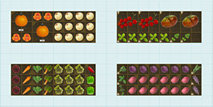How to grow Sage?
- Latin Family: Lamiaceae
- Latin Genus: Salvia
- Ease of Growing: Easy
- Growing Type: Perennial
Sage is a grayish green perennial herb with aromatic evergreen foliage. It bears beautiful purplish blue flowers that attract hummingbirds. It's used extensively for flavoring rich, savory dishes.
Videos
Sage History
Sage is a native of the northern Mediterranean coast and has been one of the indispensable culinary herbs since medieval times. Cooking wouldn’t be the same without it.
Soil Preference
- PH (min/max): 5.6 - 7.8
- PH Ideal (min/max): 6.0 - 6.5
Sage will grow in any well-drained garden soil, but prefers a light, slightly alkaline soil. If the soil will not drain then grow it in a raised bed.
How to care for Sage?
Sage is a tough and drought tolerant plant and once established it doesn't need much attention. It normally lasts for 4 or 5 years, though tends to get woody with age.
Sage doesn’t like very cold weather and may not survive the winter outdoors in very cold climates. In which case it could be potted up and brought inside for winter use (or kept dormant in a cool garage).
Water
Sage is a very drought tolerant plant and is probably more often harmed by too much water, rather than too little.
In very dry areas it will be more productive if watered occasionally.
Fertilizer
Sage will grow in any well-drained soil, it doesn't need to be very fertile.
Seeds
Seed Viability: 3 - 5 years
Sage is very attractive to bees and produces seed quite readily (the flowers are hermaphrodite, containing both male and female parts), but normally you remove the flowers before they do so (to prevent them wasting energy). If you want seed just leave them to it and make sure you collect the small seed capsules before they fall.
Light
Sun: min. 6 hours daily
This Mediterranean herb loves full sun, though in very hot climates it will also grow in partial shade.
Conditions:Cold, Cool, Warm, Hot
Season:Short Season, Long Season
Storage
Sage is best used fresh, but it is also good dried. Pick whole branches just before they flower and dry them indoors (they dry well). Hang in bunches or lay out on a screen and dry. Store in air tight containers.
Storage Req: Drying
Storage Temp: 55-70°F
Storage Length: 1-180 days
Problems
Sage Types
- Green Sage
Sometimes known as Dalmatian Sage, this is the Garden sage famed for culinary purposes. While a sage plant is in its prime, it makes an attractive addition to both herb gardens and ornamental borders.
Pests
- Lace Bug
- Leafhoppers
- Mealybug
- Slugs and snails
- Spider Mites
- Thrips
- Whiteflies
- Deer
Diseases
- Aster Yellows
- Rust
- Damping Off
- Powdery Mildew
